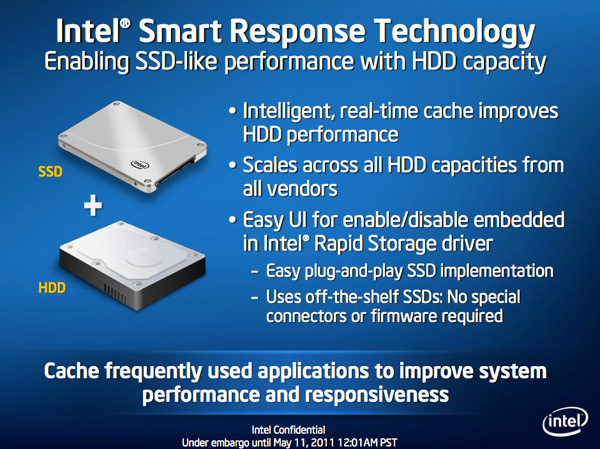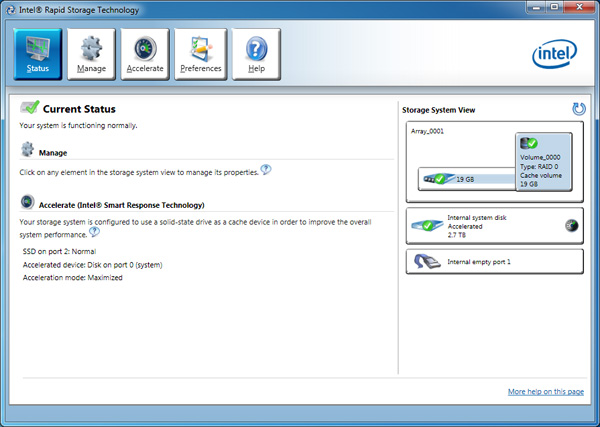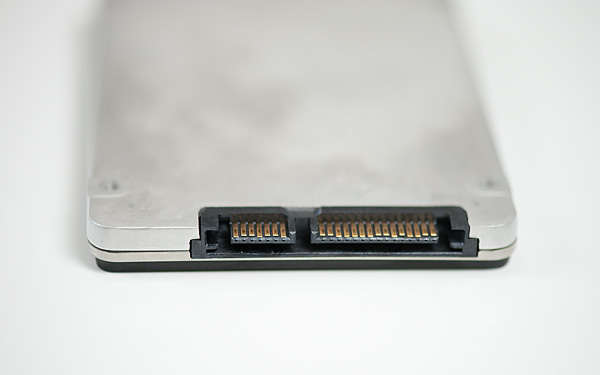Intel Z68 Chipset & Smart Response Technology (SSD Caching) Review
by Anand Lal Shimpi on May 11, 2011 2:34 AM ESTSSD Caching
We finally have a Sandy Bridge chipset that can overclock and use integrated graphics, but that's not what's most interesting about Intel's Z68 launch. This next feature is.
Originally called SSD Caching, Intel is introducing a feature called Smart Response Technology (SRT) alongside Z68. Make no mistake, this isn't a hardware feature but it's something that Intel is only enabling on Z68. All of the work is done entirely in Intel's RST 10.5 software, which will be made available for all 6-series chipsets but Smart Response Technology is artificially bound to Z68 alone (and some mobile chipsets—HM67, QM67).

It's Intel's way of giving Z68 owners some value for their money, but it's also a silly way to support your most loyal customers—the earliest adopters of Sandy Bridge platforms who bought motherboards, CPUs and systems before Z68 was made available.
What does Smart Response Technology do? It takes a page from enterprise storage architecture and lets you use a small SSD as a full read/write cache for a hard drive or RAID array.
With the Z68 SATA controllers set to RAID (SRT won't work in AHCI or IDE modes) just install Windows 7 on your hard drive like you normally would. With Intel's RST 10.5 drivers and a spare SSD installed (from any manufacturer) you can choose to use up to 64GB of the SSD as a cache for all accesses to the hard drive. Any space above 64GB is left untouched for you to use as a separate drive letter.
Intel limited the maximum cache size to 64GB as it saw little benefit in internal tests to making the cache larger than that. Admittedly after a certain size you're better off just keeping your frequently used applications on the SSD itself and manually storing everything else on a hard drive.
Unlike Seagate's Momentus XT, both reads and writes are cached with SRT enabled. Intel allows two modes of write caching: enhanced and maximized. Enhanced mode makes the SSD cache behave as a write through cache, where every write must hit both the SSD cache and hard drive before moving on. Whereas in maximized mode the SSD cache behaves more like a write back cache, where writes hit the SSD and are eventually written back to the hard drive but not immediately.
Enhanced mode is the most secure, but it limits the overall performance improvement you'll see as write performance will still be bound by the performance of your hard drive (or array). In enhanced mode, if you disconnect your SSD cache or the SSD dies, your system will continue to function normally. Note that you may still see an improvement in write performance vs. a non-cached hard drive because the SSD offloading read requests can free up your hard drive to better fulfill write requests.
Maximized mode offers the greatest performance benefit, however it also comes at the greatest risk. There's obviously the chance that you lose power before the SSD cache is able to commit writes to your hard drive. The bigger issue is that if something happens to your SSD cache, there's a chance you could lose data. To make matters worse, if your SSD cache dies and it was caching a bootable volume, your system will no longer boot. I suspect this situation is a bit overly cautious on Intel's part, but that's the functionality of the current version of Intel's 10.5 drivers.
Moving a drive with a maximized SSD cache enabled requires that you either move the SSD cache with it, or disable the SSD cache first. Again, Intel seems to be more cautious than necessary here.
The upside is of course performance as I mentioned before. Cacheable writes just have to hit the SSD before being considered serviced. Intel then conservatively writes that data back to the hard drive later on.
An Intelligent, Persistent Cache
Intel's SRT functions like an actual cache. Rather than caching individual files, Intel focuses on frequently accessed LBAs (logical block addresses). Read a block enough times or write to it enough times and those accesses will get pulled into the SSD cache until it's full. When full, the least recently used data gets evicted making room for new data.
Since SSDs use NAND flash, cache data is kept persistent between reboots and power cycles. Data won't leave the cache unless it gets forced out due to lack of space/use or you disable the cache altogether. A persistent cache is very important because it means that the performance of your system will hopefully match how you use it. If you run a handful of applications very frequently, the most frequently used areas of those applications should always be present in your SSD cache.
Intel claims it's very careful not to dirty the SSD cache. If it detects sequential accesses beyond a few MB in length, that data isn't cached. The same goes for virus scan accesses, however it's less clear what Intel uses to determine that a virus scan is running. In theory this should mean that simply copying files or scanning for viruses shouldn't kick frequently used applications and data out of cache, however that doesn't mean other things won't.













106 Comments
View All Comments
jordanclock - Wednesday, May 11, 2011 - link
You can use a drive for both, but you must set up your data partition AFTER you set up the cache partition.jorkolino - Wednesday, June 6, 2012 - link
What do you mean by that? You partition the SSD drive, install the OS in the first partition, set-up the other partition as a cache, and then format your remaining HDD?jorkolino - Wednesday, June 6, 2012 - link
I wonder, can you tell SRT to cache blocks only from the HDD onto the cache partition, because by default SRT may decide to cache system files that already reside onto a fast SSD partition...evilspoons - Wednesday, May 11, 2011 - link
I know it's early on for Z68, but I'm curious how other SSDs will perform in SRT mode. I ask because the 40 GB X25-V is on sale here for half its usual price...evilspoons - Wednesday, May 11, 2011 - link
To answer my own question, Tom's Hardware reviewed SRT with several SSDs and to put it bluntly, the X25-V sucks. Its very low write speed of 35 mb/sec actually drags the hard drive down in a few tests.Shadowmaster625 - Wednesday, May 11, 2011 - link
Yeah that is a nice way of putting it. Talk about sugar coating. Here is a question for ya: was intel being "conservative" when they tried to shove rambus down everyone's throats? If it werent for AMD and DDR god knows how much memory would cost now. I still have one of those rambus P4 systems running in the lab right now. (intel 850 chipset with dual channel RDRAM). I did some memory benchmarking on it and was shocked to find that it was actually slower than any of the P4 DDR 266 machines we have running. (Yes we are slow to upgrade lol.) It runs at about DDR200 equivalent speeds. And we really paid out the wazoo for that system.Shinobisan - Wednesday, May 11, 2011 - link
discrete graphics cards are limited - even though they often have three, four.. or more connectors these days, they can often only drive two monitors at a time. (unless you use a displayport connector... and monitors with DP don't really exist yet)I have two monitors driven by my HD6950 via the digital video out connectors. So the HDMI connector on that card is "dead" until I turn one of the monitors off.
What I would like to be able to do... is have my dGPU drive my two monitors, and the iGPU drive my 1080p TV via HDMI.
Can I do that? This discussion on virtu muddies the water some. unclear.
Conficio - Wednesday, May 11, 2011 - link
Well, so SRT is a good idea but again it is limited artificially in its use. Sounds to me like the P67/H67 stund all over again.Why is it limited?
* For starters it is driver supported, and I believe that means Windows only (I could find no mention of what OS is supported). To be fully useful it belongs into the chipset/BIOS realm.
* Next there is the artificial 64GB limit. As is obvious from even the tests that is not really the practical limit of its usefulness. It is simply a marketing limit to not compete with Intels own full SSD business. You got to ask yourself, why not use your aging SSD of 100GB or 256 GB (a couple years down the road) as an SRT drive?
* "With the Z68 SATA controllers set to RAID (SRT won't work in AHCI or IDE modes) just install Windows 7 on your hard drive like you normally would." So only RAID setups are supported? Well you are testing with a single hard drive, so this might be a confusing statement. But if it is RAID only then that is ceratinly not what Joe Shmoe has in its desktop (let alone in its Laptop).
A5 - Wednesday, May 11, 2011 - link
If the AT Heavy Workload Storage Bench is a typical usage case for you, than you shouldn't be using SRT anyway - you'd have a RAID array of SSDs to maximize your performance.jordanclock - Wednesday, May 11, 2011 - link
For caching purposes, I'm sure 64GB is a very reasonable limit. The more data you cache, the more data you have to pay attention to when it comes to kicking out old data.And it isn't a RAID set up, per se. You set the motherboard to RAID, but the entire system is handled in software. So Joe Shmoe wouldn't even have to know what a RAID is, though I don't see Joe Shmoe even knowing what a SSD is...